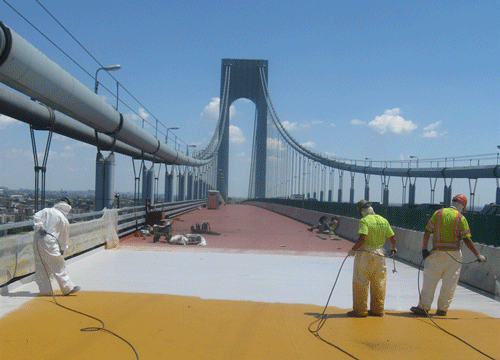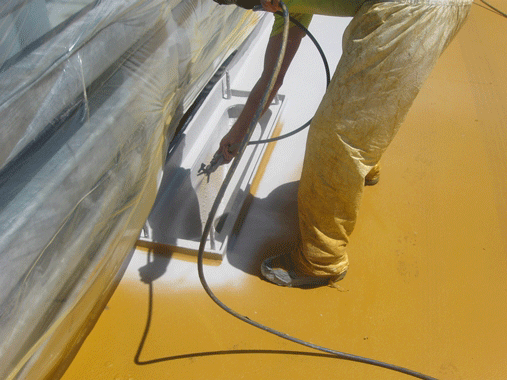An innovative waterproofing system was recently installed to upgrade the Verrazano-Narrows Bridge over the New York Harbor in the United States. The waterproofing project is set to finish this spring, with work only carried out during restricted timeframes in order to create minimal disruption to traffic.
The double-decked suspension bridge is 7,176-m long and 198-m high, allowing ship traffic to pass beneath it into the Port of New York and New Jersey—which encompasses the system of navigable waterways near the shorelines of northeastern New Jersey and New York City. Built in the late 1950s, the bridge is a key route for U.S. East Coast motorists, with ~190,000 vehicles passing over it daily.
The result of the large volume of traffic and heavy use, however, was that the 50-year old upper level deck required replacement to make way for a lighter-weight orthotropic deck made of durable steel. This type of deck is usually comprised of a structural steel plate stiffened either longitudinally or transversely, or in both directions. This enables the structure to bear vehicular loads while enhancing its load-bearing properties. The deck may be integral with or supported on a grid of framing members, such as floor beams and girders.
In addition, refurbishment works specified for this project included the creation of a seventh lane, to be used for buses and high-occupancy vehicles.
Proven Performance on Bridge Decks
Project specifiers with the New York Metropolitan Transportation Authority (MTA) were looking for a waterproofing product with a proven track record on long-span bridge decks. In addition, the solution had to withstand extreme temperatures—as this bridge is subject to more diverse weather conditions than most other bridges due to its proximity to the Atlantic Ocean.
To that end, the Eliminator† spray-applied bridge membrane system from Stirling Lloyd (Knutsford, United Kingdom) was ultimately selected. The company says its system has no vulnerable joints and is protecting the decks of many of the world’s largest steel deck bridges. The system was designed to act as a barrier across the entire expanse of the Verrazano-Narrows Bridge deck, and effectively prevent steel corrosion over the lifespan of the structure.
“As a key route between Staten Island and Brooklyn, the waterproofing of the Verrazano-Narrows Bridge had to be carried out efficiently with the least disruption possible,” says Tom Carter, vice president with Stirling Lloyd. “The program presented numerous challenges due to the variable and extreme weather conditions, restricted working hours, and short possession times.”
According to the company, the system forms a tough, flexible, and seamless membrane that resists attack by oil, fuels, chlorides, and dilute mineral acids. In addition, the system incorporates components that enhance the membrane’s bond to both the asphalt paving and the deck. This strong bond throughout allows the steel deck, waterproofing, and paving to behave as a composite—which the membrane’s developers say is critical to withstanding diverse weather events, including snow and cold weather in New York’s winters and extreme heat that can reach nearly 100 °F (37.8 °C) during the summers.
Maintenance Phases
The maintenance work was carried out in stages, beginning in 2015. First, the old roadway decking was split into sections. In order to facilitate the short windows of working time, the deck was cut, removed, and replaced in sections. Those sections were then lifted up and out, one at a time, before being replaced with prefabricated deck panels. This method was engineered so minimal disruption to the traffic flow is created.

Aside from the orthotropic deck waterproofing, each section of new roadway had to include other key elements: a finger joint installation, bridge barrier, bridge drainage system, asphalt overlay, new sign structures, and upper and lower deck roadway lighting.
General contractor Tutor Perini (Los Angeles, California) and authorized contractor Venture Construction (Concord, New Hampshire) were given a challenging construction timeline from the MTA, owing to the area’s dense population. As such, they required a product that could be installed quickly.
Fortunately for the contractors, the waterproofing system typically cured within the hour and was durable enough by then to withstand a heavy load—which allowed other trades to immediately access the site.
“With the bridge only closed for short periods of time, this was a crucial benefit to the project,” Carter says.
Applying the System
The 55,000-m2 of new deck was prepared by shot blasting using metallic blast medium. Spot adhesion tests were conducted to ensure the waterproofing system would bond to the deck.

After the surface preparation, a fast-curing methyl methacrylate (MMA) primer was applied to the concrete portions of the substrate, while a separate metal primer was used to enhance adhesion to the steel. The primers, which helped to seal the deck, were spray applied in two color-contrasting coats to aid quality control and membrane integrity.
From there, the membrane system was applied in two color-coded coats of equal thickness. Wet film thickness checks were done to constantly monitor that the required 60 mils (1,524 μm) thickness of the yellow first coat and 60 mils (1,524 μm) thickness of the gray second coat were met. Each coat cured and could be trafficked within one hour.
Finally, a bond coat was applied at the conclusion of application to promote adhesion of the paving to the membrane. The bond coat is a critical component, the company explains, because it produces high bond in shear and tensile strength between the waterproofing and the paving.
“This is always an important feature of the system on any bridge, but it assumes a higher importance on long-span orthotropic decks—because orthotropic decks are more flexible than most types of bridge decks and create dynamic forces that promote the delamination of paving in the absence of a high bond mechanism,” Carter explains.
The waterproofing application commenced in the summer of 2015, and continued in stages throughout 2016 and early 2017 before concluding in the spring.
“[The system’s] credentials meant that it was a perfect solution for the project, as it offered the long-term protection that will ensure the Verrazano-Narrows Bridge stands the test of time and the peace of mind that the NYMTA sought,” Carter says.
Source: Stirling Lloyd, stirlinglloyd.com.
†Trade name.